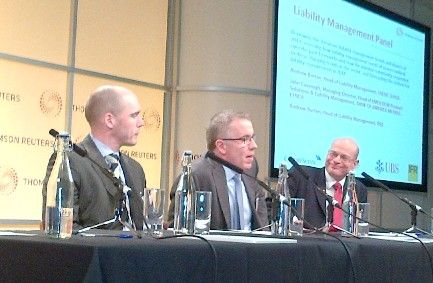After years of waiting for regulatory uncertainty to lift and issuance to begin, the market finally got started in 2013 with four Additional Tier 1 transactions launched so far, and an uptick in Tier 2 volumes.
And what happens to those instruments will be key to the health of what is expected to be a US$1.4trn-equivalent market for European and US banks combined, according to Citigroup’s estimates.
“The risk profile is different whether you think about a bank hitting a trigger or them not paying coupon. You have a much higher risk of seeing your coupons deferred,” said Andreas Doerrenhaus, head of investment management Europe, fixed income at BlackRock.
In the case of a US$2bn Additional Tier 1 priced by Barclays Bank last week, for example, the firm estimates that the capital cushion that protects investors from potentially having coupon payments suspended will shrink from £15bn in 2016 to £7bn in 2019 as higher capital requirements kick in.
“The fact that it’s subordinated doesn’t make these instruments bad. You might be better off buying a Tier 2 CoCo than buying the equity in a bank that’s not profitable.”
This is because the level at which Barclays becomes subject to additional restrictions on making coupon payments will be raised from 7% Core Equity Tier 1 to 9%.
Georg Grodzki, head of fixed income at Legal & General, added that banks were unlikely to be as worried as previously when it comes to skipping coupons.
“The investor base that is buying these instruments right now is different from the one buying the banks’ senior debt. This will make it easier for them to skip coupons because investors will have less of a stick.”
He said the new instruments were far riskier than old style Tier 1 debt. “If you thought you got burnt the previous time around, then you shouldn’t be buying these. This is equity without the voting rights.”
On another panel, bankers said the issuers and regulators needed to make sure the market was aware of all the risks attached to these instruments.
“The market is generally clear around what these instruments are supposed to do. However, regulators need to be clear how they will evaluate failure of an institution so that investors can measure risk,” said Tim Skeet, board member of the ICMA.
Disaster scenario
European bankers also debated disaster scenarios for Additional Tier 1 bonds if banks that have issued them don’t pay the coupons.
“In one scenario, the action won’t come as a shock to the market as the instrument will have already been downgraded by around six notches by the likes of Moody’s and S&P before a bank’s board is having this discussion,” said Rob Baston, managing director DCM at UBS.
If this scenario were to play out, one banker imagined that the price of the bond would fall by around 15-20 points and other similarly structured deals would also drop as a knock-on effect.
Or alternatively, the market could be caught completely off guard, and in that instance, bankers believe that issuers would struggle to sell these instruments after the next crisis.
“The market needs to accept that everything is now loss absorbing and Additional Tier 1 are at the first line of a bank’s defence,” said Sandeep Agarwal, head of EMEA DCM at Credit Suisse.
In a research note published recently, Citigroup analysts said that European Additional Tier 1 bonds have a very binary value and would either trade around par or on the option value of a future reinstatement of coupons, “which most likely implies a valuation well below 50 and quite conceivably even in the teens. There really isn’t very much in between. It is an investment based on faith.”
Some investors are realistic on the risks.
“It’s not just about Additional Tier 1, it’s about who is issuing, what the exact structure is, what the yield is,” said Doerrenhaus. “The fact that it’s subordinated doesn’t make these instruments bad. You might be better off buying a Tier 2 CoCo than buying the equity in a bank that’s not profitable.”
